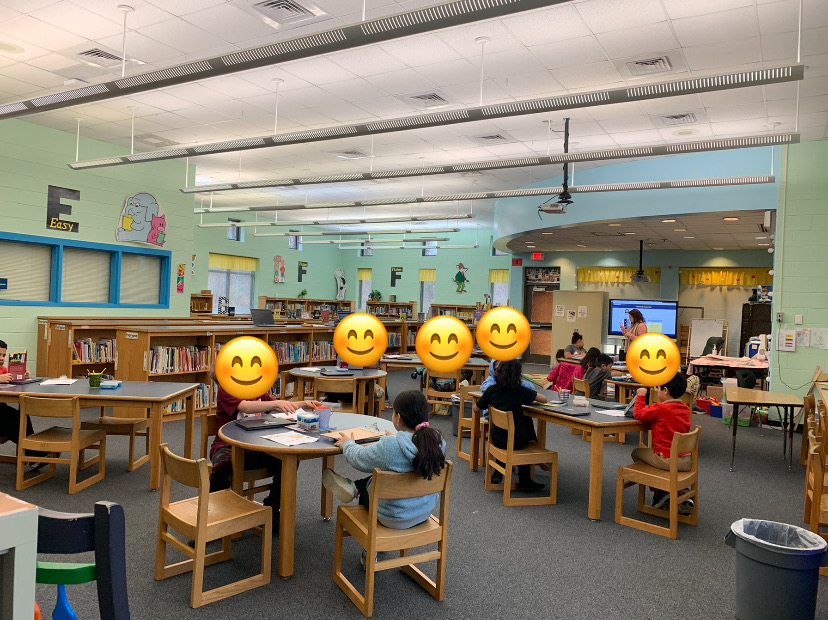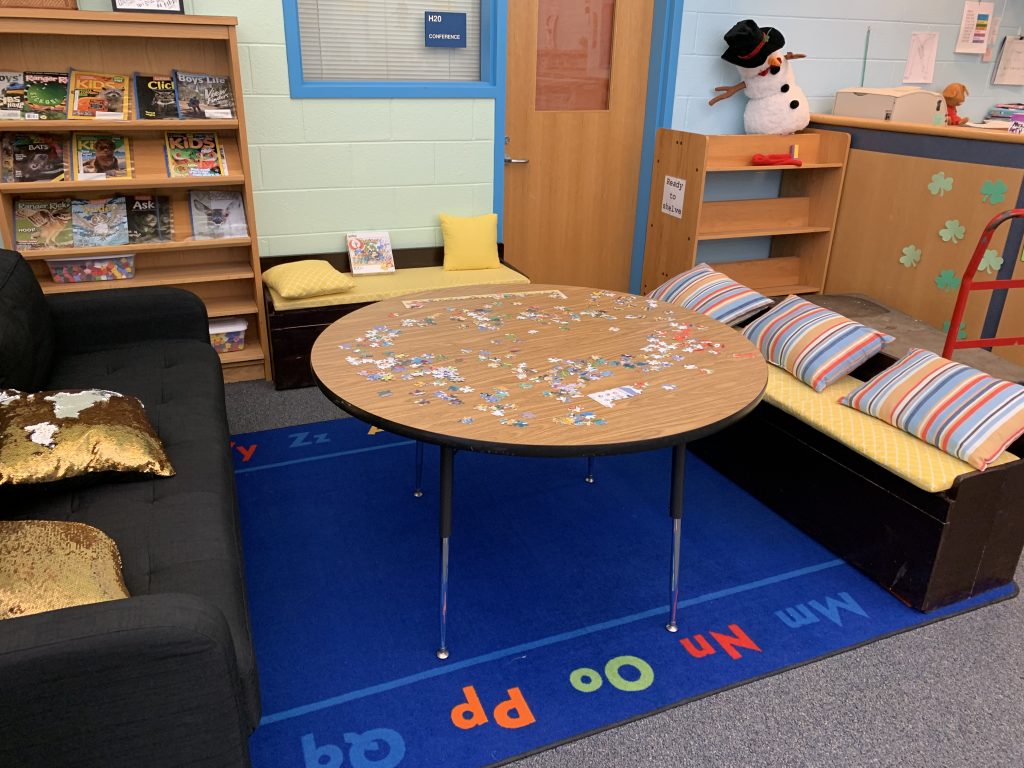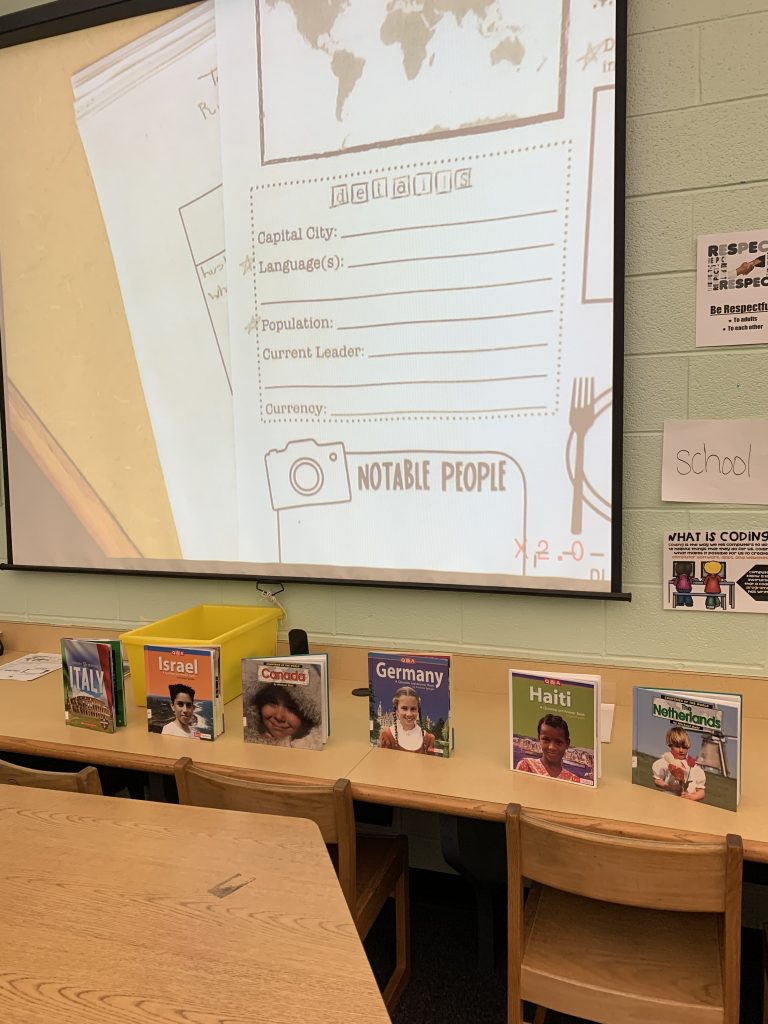For my first library observation I chose to visit my elementary school’s library, located in Spotsylvania County, Virginia. I have worked as a reading specialist at this school for three years and have spent quite a bit of time in the library; however, I realized I had never taken a close, critical look at it before. I discovered several positives and some areas of improvement in the access, resources, services and space that my school library provides.

The Space and Physical Access
My elementary school is structured ‘open-campus’ style, with outdoor hallways and classrooms that open up to outdoor space and courtyards. Our library is part of what I would consider the main hub of the school. It is a newer building that was added to house the library, music and art rooms, and guidance counselor offices. The entire building gives off a feeling of comfort and creativity. The library itself is large, open and airy with tall ceilings, lots of light, bright walls, decor, themed displays and bulletin boards. Even though the physical space is large, the librarian has taken care to create smaller purposeful spaces within it. There are tables and chairs for more structured student work time, cozy reading nooks tucked in between bookshelves next to windows, an area for computers and technology resources, a carpeted storytime area, and couches where students can sit to read or work on a jigsaw puzzle as part of a “one school, one puzzle” initiative. Mostly everything in the library is easily accessible for elementary-sized children, except for a few taller bookshelves and displays that contained chapter books.

I admire my school librarian’s attention to detail in the displays she creates and the frequency with which she changes them out to keep students interested. Some of the displays include a ‘Got Caught Reading’ bulletin board featuring photos of students reading all around the school, a “Readbox” bookshelf with popular titles that students can ‘rent’ like the Redbox movie consoles, and themed book collection displays for Black History Month and St. Patrick’s Day. While I was visiting the library, I noticed many students browsing the books that were located in these areas.
Digital Access
I will admit, I had never visited our library’s website before and it took some time to figure out where it was located. Library resources are listed at the very bottom of our Student Dashboard page. It includes links to Destiny, which is our online catalog where students can browse and put books on hold, and Sora, which is where students can access e-books. Both of these require student’s school log in credentials in order to access them. The website also provided video tutorials for how to use these resources in both English and Spanish. Through Destiny, students are given access to other resources such as World Book, Unite for Literacy, PebbleGo and Britannica Kids.
Services and Intellectual Access
We are a Title I school that serves a diverse population of various ethnicities and socioeconomic statuses. Within this student population we have students who are English language learners, economically disadvantaged, homeless, gifted, and receiving special education services (learning disabilities, visually impaired, speech/language impairment, and related services). We also have many students who are receiving reading interventions.
Our school library is organized mostly by the Dewey Decimal system, with some special areas that are focused on theme or author/series studies. Our library caters to many of the students that we serve, but I did discover some areas that could be improved. Positives include displays celebrating Black History Month, labels and signs written in kid-friendly language with pictures to go with each for early readers, and a small area with bilingual and Spanish books for our English language learners. However, given how many English language learners we have, I was surprised that this area was not larger. I was also disappointed to see that we do not have any resources for our visually impaired students, such as braille books or audiobooks. Our librarian told me that is something she is currently working on for our school (V. Copas, personal communication, March 9, 2022).
People – Patrons and Staff
Our library is staffed by two people: a school librarian and a library assistant. This is our school librarian’s first year in this position, after our previous librarian retired last year. Her main responsibility is planning and teaching library lessons to each grade during their ENCORE time. She collaborates with classroom teachers so that she knows what to build on, reinforce, or teach based on what they are learning in their rooms. The library assistant helps with book circulation, shelving, and checking books in and out.
While visiting the library, I was able to see how the library functions during a third grade class period. The librarian had recently finished a whole group lesson on researching different countries around the world. Students were engaged in a variety of activities. Some were working independently at tables, reading books on their country and taking notes in a graphic organizer. Some were working in pairs with their organizers on clipboards in the cozy reading nook areas. Some students were finished and were browsing books to check out, or reading around the room. The librarian circulated around, asking and answering questions and providing support when needed. The library assistant was checking books in and out and organizing materials. The students all seemed comfortable and engaged in the work they were doing.

Collections
Our new school librarian has already made many positive changes, including expanding the school’s collection to include more diverse and current books that reflect our students and the community we serve. She also makes sure to display these types of books in a prominent way, so that students are seeing them and able to see themselves in their library. This ties into two of the AASL’s best practices for school librarians: “Provide up-to-date print and digital collections that reflect the diversity of the larger global community. Ensure that displays and communications focus on resources in multiple formats that reflect a variety of viewpoints, cultures, and experience” (Rubin & Rubin, 2020, p. 165).
In addition, she has made an effort to incorporate more technology into every lesson for every grade level. Students are regularly using and being exposed to computers and STEM technology tools like coding, programming robots, and 3D printing, even as early as kindergarten. She also uses her SMARTboard and document camera daily. This is a change from our previous librarian who was not as comfortable with these types of instructional tools.
Conclusion
I really enjoyed observing in my school’s library. Overall, it is a welcoming environment that students look forward to visiting. As the ALA (n.d.) states, “School libraries are places of learning and exploration where teachers and professional school librarians help students develop essential information, reading, technological, visual, textual, and digital literacies that are crucial to student success in the 21st century.” With our librarian’s vision, I know that it is becoming a place that is inclusive and fosters a love of learning and literacy for all.
References
American Library Association. (n.d.). About America’s libraries. I Love Libraries. http://www.ilovelibraries.org/what-libraries-do/about-americas-libraries
Rubin, R. E. and Rubin, R. G. (2020). Foundations of library and information science (5th ed.). ALA Neal-Schuman.
Katie,
I really enjoyed reading about your school library experience, and hearing about the details that stood out when you viewed it through a more critical lens. The library seems very inviting, based on your pictures and descriptions. I like the idea of a Readbox section, and would be interested in incorporating that into my public library YFS space. I think it would appeal to families who are short on time and want some grab-n-go selections. We could highlight specific areas of our collection with a Readbox as well. I found it interesting that your library uses the Dewey Decimal system, since that is a very complicated method and in my department we find that both children and parents struggle with it. Marrocolla says in her article that “we would never want our public library users to be confused in their school libraries, or vice versa. By keeping our classification the same as our schools’, we would support the use of the school library and the work of the school librarian, as well as reinforce the library skills our child patrons were learning in school. But Dewey is in many ways an outdated mess” (2019). I look forward to the day libraries across the nation decide to make a change and unite to find a better (less confusing) way to serve their patrons. Perhaps this is the generation of children who deserve to grow up with something more user friendly!
Reference:
Marrocolla, E. G. (2019, October 1). The trouble with Dewey. School Library Journal.
https://www.slj.com/story/The-Trouble-with-Dewey-libraries
Hi Hannah,
Thank you so much for your comment! I agree, I was also surprised to see that our school library is organized using the Dewey Decimal System. It is definitely confusing – while I was observing a student asked me where to find a certain type of book and You make a great point that school and public libraries should use a system that is consistent for ease of use. How is the children’s area of your library organized? I know that you mentioned in your public library post that the branch was organized by genre- is that the same as your branch and do you use Dewey? I would love to hear other ideas. I’m also curious to speak to my school librarian to see if she has any plans for change in the future. She is in her first year as a librarian and recently finished her MLIS program, so I’m wondering if she has been reflecting on this topic as well. Thank you for giving me something to think about!
Katie,
Yes my library branch is organized using Dewey, and it is my goal to change that! The more I learn about Dewey (both the man and the method), the more I hope the future libraries can be separated from this relic of the past. It is very confusing for patrons, even those older generations who were supposedly raised using it. Keeping subjects in order according to an archaic numbering system is not high on anyone’s list these days, and I will freely admit that I did not understand it before I started working in a library! I would organize the nonfiction alphabetically by heading, separated by subtopic, and still use a numeric system to keep things in categories. For example, the A section would have topics such as Animals, which would then be divided into types of animals (birds, mammals, reptiles, etc.) and further subdivided by species (whales would include humpback, blue, orca, etc.) I’m sure those with more organized brains than mine have better ideas, but this is one way we could move away from a confusing and outdated numerical system.
That’s a great idea! I am wondering if we will learn more about ways to categorize and organize in another one of our upcoming core classes. Maybe then we will have more ideas for how to inspire change in our libraries 🙂
Hello all,
As I know I’m coming into this conversation a little late I would still like to weigh in on the Dewey Decimal System. We are considering a change in our school library as well. Not only do the students find it difficult to deal with and we, library staff, find the man a bit off-putting ;), the call numbers on the spines of the book in many cases have been truncated to 1 or 2 decimal places which isn’t terrible but it really confuses people when they are shelving the books – things tend to just get “shoved” in some where close to where they actually belong (an example 973.82 and 973.8 and 973.825 are all lumped together – and don’t get me started on the 590s or 636s what a mess!) I am very interested in learning more about different systems of categorizing the titles. I truly love some of the ideas your librarian has in place such as the “Got Caught Reading” board, which I may have to steal, and the Readbox – just too cute. I will say hooray to her as well for implementing more technology into her classes because as Rubin states “Each time a library adopts a new technology, the functions and the culture of the library evolve in some way.” (Rubin and Rubin, 2020, p.249) Technology certainly changes the culture of the library from what is perceived as a quiet dusty place to a modern interesting space that younger patrons are more attracted to.
Rubin, R. E. and Rubin, R. G. (2020). Foundations of library and information science (5th ed.). ALA Neal-Schuman.
Thank you for sharing Margee! I think it’s important to constantly reflect on our practices – even those like the Dewey Decimal System that have been in place for so long. Just because it’s the way it’s always been doesn’t mean it’s the best way anymore. I am excited to learn more about how we can make our collections more friendly and accessible for both our users and our staff.